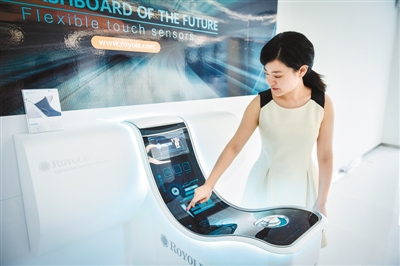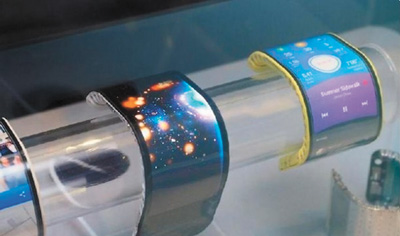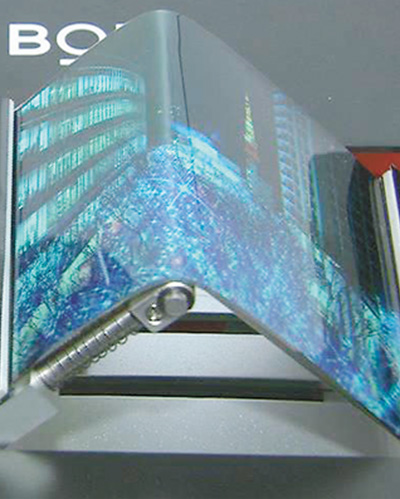A tablet phone can be turned into a watch in seconds, and a tablet computer can be folded into a mobile phone.



Baiwan mobile phone without a word?
This is not a joke, but a well-known manufacturer’s "black technology" shown to visitors at his own technology conference — — Flexible screen equipment still in the prototype stage.
One of them is a foldable and deformable mobile phone, which is a 7-inch tablet computer when surfing the Internet, watching dramas and sending and receiving emails. When you want to make a phone call, just fold it in half and it will become a smart phone of about 5 inches. The other is a flexible bracelet-like device, which unfolds into a 4-inch straight mobile phone and turns into a watch in seconds after curling.
Flexible and foldable, this is the flexible screen favored by terminal manufacturers recently. Recently, many mobile phone manufacturers have shown smart phones with flexible screen design to the outside world, and several large display manufacturers have announced that they will realize mass production of flexible screens this year.
So, what is a flexible screen? Why are flexible screens sought after? What changes will it bring to people’s lives?
What is a flexible screen?
Display screen with plastic as substrate and OLED display material.
"Flexible screen is the abbreviation of flexible display screen, which is an innovative breakthrough realized with the change of display technology, mainly the development of OLED technology." Wang Dawei, vice president of BOE Technology Group and head of the flexible technology team, told the reporter that traditional display screens all use glass as the substrate material, and then add various functional layers or components such as triode array, liquid crystal or luminescent layer on this substrate material; Flexible screen is a display screen made of plastic as substrate material and various functional layers or components.
"Glass is difficult to bend and fold, while plastic can bend at will, so flexibility is opposite to rigidity, mainly because the substrate material is different." Wang Dawei said that he showed the reporter samples of BOE’s flexible screen — — Plastic film with a size of about 5.5 inches and a thickness of about 1 mm. The reporter weighed it gently. In addition to being light and thin, it is no different from ordinary film in appearance, and it is easy to fold and bend. But after connecting the circuit signal, this film instantly lights up like a mobile phone screen.
According to reports, at present, most of the commonly used computers, color TVs and mobile phone displays use liquid crystal display technology (LCD), and the LCD itself cannot emit light, so complicated components such as backlight, polarizer and color filter film are needed, and the thickness of the screen is difficult to reduce.
Wang Dawei made an analogy. The common LCD screen is like a sandwich with two pieces of glass sandwiched between them. The liquid crystal can adjust its brightness, but it needs a light-emitting component to provide backlight, so as to realize color display.
Different from liquid crystal display technology, OLED display technology realizes the self-luminescence of display materials. In BOE’s laboratory, the reporter saw these new display materials — — White powdery solid placed in bottles and jars. "These are luminescent materials, and different arrangements and combinations will emit different lights such as red, yellow and blue." Wang Dawei introduced that each of these powders is more expensive than gold, and the most expensive is 10,000 yuan a gram. Because of the self-luminescence, the display screen made of OLED technology no longer needs backlight, color filter and other components, and these display materials are very thin, and OLED display screen is much thinner than LCD display screen.
"LCD displays need two glass substrates, and OLED displays only need one substrate material as the bottom layer. The display material evaporated on the substrate can make the screen glow. Changing this substrate material from glass to plastic film becomes a flexible screen that can be bent and folded. " Wang Dawei further explained that OLED technology can be applied to both plastic substrates and glass substrates; While LCD can only be applied to glass substrates.
What changes will the flexible screen bring?
In the future, the screen will change at will, "display" will be everywhere, and the display screen may be embedded in clothing and jewelry.
So, what are the characteristics of the flexible screen besides being bendable?
According to experts, the flexible screen using OLED technology is not only thinner in size, but also lower in power consumption than the original device, which helps to improve the endurance of the equipment. At the same time, the contrast is higher, and it has better performance in color brightness and clarity. The flexible screen can also be stretched by external force to achieve the effect of curling and stretching, so that the size can be switched at will without affecting the display clarity. In addition, due to the use of plastic substrate, the durability of flexible screen is higher than that of previous screens, which can reduce the probability of accidental damage to equipment.
Therefore, as soon as the concept of flexible screen was introduced, it was enthusiastically sought after by the market.
The flexible and foldable screen, coupled with low energy consumption, gives terminal manufacturers a huge imagination space and will also bring all kinds of brand-new changes to people’s lives. This is not only reflected in the field of mobile phones, but also in home TVs, notebook computers, car monitors, wearable devices and so on.
In the future, our computers may be thinner and more portable. At present, some scientific and technological enterprises have demonstrated new computers based on flexible screens. This computer screen can be automatically rolled up with one button, and it is as easy to carry around as a pen. Coupled with a soft, lightweight, flexible and ultra-thin transparent keyboard that weighs only a few grams, the reporter wants to abandon his laptop that weighs one kilogram in minutes.
Our car space may be more spacious in the future. Because the flexible display screen can better fit the complex space inside the car, the central control area of the car does not have any redundant physical buttons, but integrates the interactive design of display, buttons and so on. Imagine that when the heavy center console in the car becomes thinner, people’s space in the car will inevitably increase a lot.
Our home life may be more intelligent in the future. The flexible screen makes "display" everywhere. When the screen is attached to the water cup, the networked display will report your health data every day when you drink water. When the screen is attached to the refrigerator, without opening the refrigerator door, the display screen will tell you what to cook today … … The size of the big color TV on the wall should be larger. When you don’t want to see it, you only need to press a button, and this color TV that occupies the whole wall will be rolled into a painting axis. In some manufacturers’ designs, flexible display screens can even be embedded in clothes, backpacks and jewelry.
In addition, because OLED can emit light by itself and consume less energy, in the future, our smart products such as mobile phones and computers may be able to be recharged for several days.
Of course, the industry expects that the application of flexible screens in real life will still start with small and medium-sized screens. Smartphones and wearable devices with flexible screens will appear in people’s field of vision earlier. In fact, among the smart phones released by Samsung, Huawei and other mobile phone manufacturers last year, some screens have realized hyperboloid bending, that is, small bending at the edge, which can be regarded as a prelude to flexible screen smart phones.
When can I see the flexible screen?
Existing enterprises can mass-produce, and will see the first flexible screen mobile phone this year.
So, what is the research and development status of flexible screen?
According to experts, since the display industry is mainly concentrated in East Asia, China, Japan and South Korea have the strongest technical strength in research and development. Flexible screen technology is the leading enterprise in the world, such as Samsung and LG. Samsung has been involved in the field of flexible screens earlier, and has a strong technical research and development force. At present, it has achieved mass production of small and medium-sized flexible displays. The United States, Japan and other countries focus on the upstream of display technology — — Research and development of new materials and equipment.
According to reports, the research and development of flexible screen is closely related to the development of OLED technology. OLED devices were first realized in the laboratory by Chinese-American professor Deng Qingyun, and the R&D boom started in 1980s. However, due to the complex process and low yield, researchers from all over the world have worked hard for more than 20 years to solve the technical bottleneck in recent years, making OLED realize industrial production.
Only display materials are not enough, and the research and development of flexible screen needs to break through the important processes of flexible display technology, such as flexible substrate production, OLED luminescent layer preparation, film packaging and peeling. After that, it will take at least one or two years to complete the detailed integration of various processes.
"From glass substrates to plastic substrates, all the processes involved must be redesigned and the materials used must be re-selected." Wang Dawei gave a simple example. Glass and plastic bear different temperatures, so the corresponding design should be changed. As far as the research and development of flexible screen itself is concerned, more than 100 new materials and equipment are needed.
It is not easy to get every new material. "At present, the traditional conductive materials used to realize the touch function of the mobile phone screen can not be bent with a small radius of curvature, and it is extremely easy to break. The conductive material based on nano-silver technology can be bent for tens of thousands of times without breaking, and the conductive performance has hardly changed, which is very suitable for touch application of flexible display products. " Cao Yu, head of C3NANO’s business in China, told reporters that the conductive material of nano-silver wire they promoted in China was successfully developed in the laboratory by Bao Zhenan, an academician of the American Academy of Engineering and a professor at Stanford University in 2010, but it took five or six years of experiments and improvement to achieve stable mass production.
Domestic flexible screen research and development has also made substantial breakthroughs. As a representative enterprise, BOE invested 46.5 billion yuan to build two sixth-generation flexible AMOLED production lines in Chengdu and Mianyang respectively, and the Chengdu production line is expected to achieve mass production this year. Other companies, such as Visionox, Tianma, Rouyu and Hehui Optoelectronics, also performed well.
According to foreign media reports, Samsung and LG are likely to launch flexible screen mobile phones first this year, and manufacturers such as Apple are also expected to release similar products in 2018. Just a few days ago, the US Patent and Trademark Office passed an Apple patent called "Flexible Input-Output Electronic Device", which showed a flexible LCD or OLED display mobile device.
For ordinary consumers, this year is worth looking forward to.
Extended reading
Display technology development trend
With the development of economy and society and the arrival of the era of mobile internet, it can be said that "display" is everywhere. The product theme of display technology has also evolved from CRT TV to liquid crystal (LCD) and then to OLED technology, and major manufacturers have set OLED as the future growth driving force.
What is CRT? It is the earliest TV imaging technology in China. The first black-and-white TV set and the first color TV set in China adopted this technology. At present, most thick TV sets are still using CRT technology. The structure of CRT TV is a vacuum tube with one or more electron guns in it. The electron guns emit electron beams. When the electron beams hit the inner side of the front screen surface of the vacuum tube, the luminescent paint on the inner side of the screen is hit by the electron beams and emits light to produce images.
The full name of LCD is liquid crystal display screen. Its structure is that liquid crystals are placed between two parallel pieces of glass, and there are controllable semiconductor devices on the two pieces of glass. The liquid crystal molecules are controlled to change direction by electrifying or not, and the light emitted by the backlight is refracted to produce pictures.
OLED is regarded as the future of display technology, which has the advantages of self-luminescence, low energy consumption, ultra-thin, flexible and curly, high color gamut and fast response. According to experts, after nearly 30 years of exploration, accumulation and layout, the advantages of OLED display technology in terms of resolution and mass production have begun to appear.
In the past, the large-scale standard panel production mode was increasingly difficult to meet the different needs of different users. People rely more and more on the internet, and this model requires the screen to appear in more places. Emerging vehicle monitors, wearable devices and e-sports all put forward different requirements for display enterprises.
According to industry analysts, East Asia has become the center of global display technology. At present, the scale of China’s display industry is soaring, making it the fastest developing country. China’s display industry has not only increased its market share, but also gradually narrowed its technological gap. In some areas, it has even achieved catch-up, and the upstream and downstream industrial chains of the display industry have gradually been established.
(Feng Hua finishing)